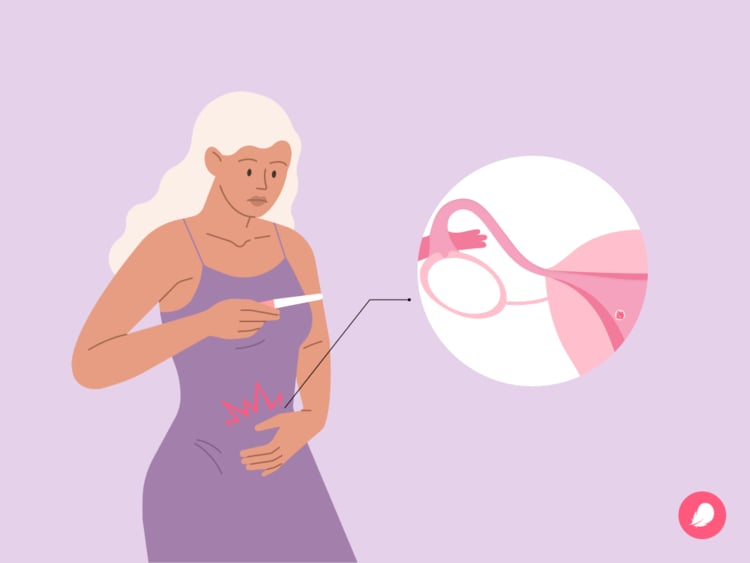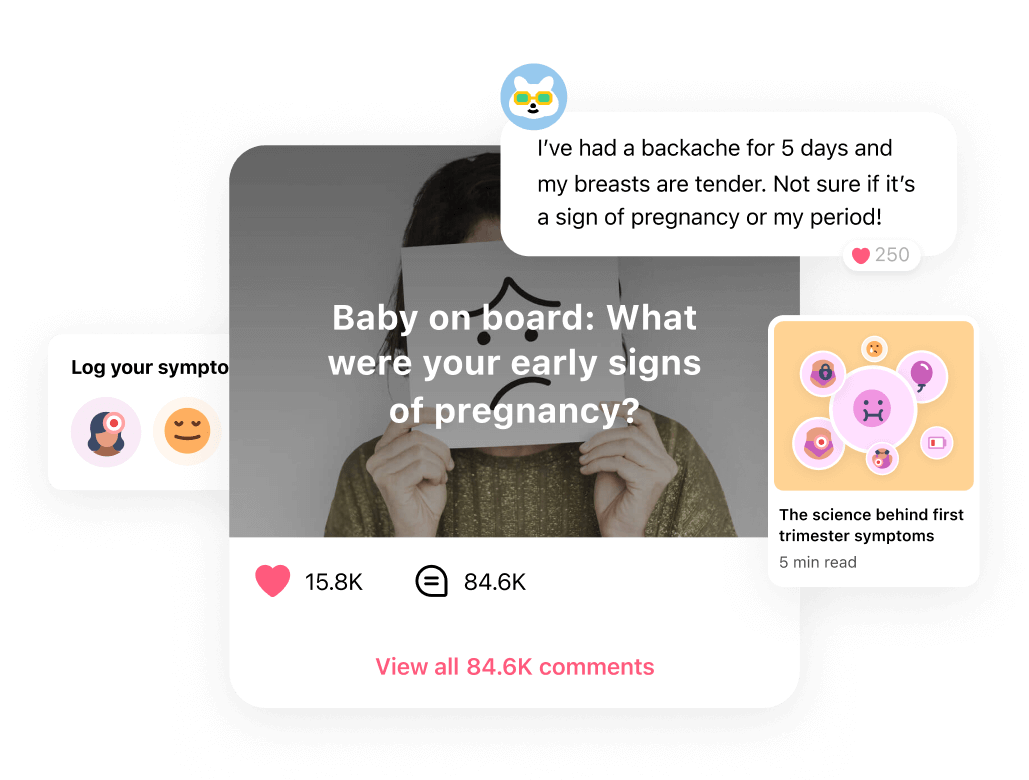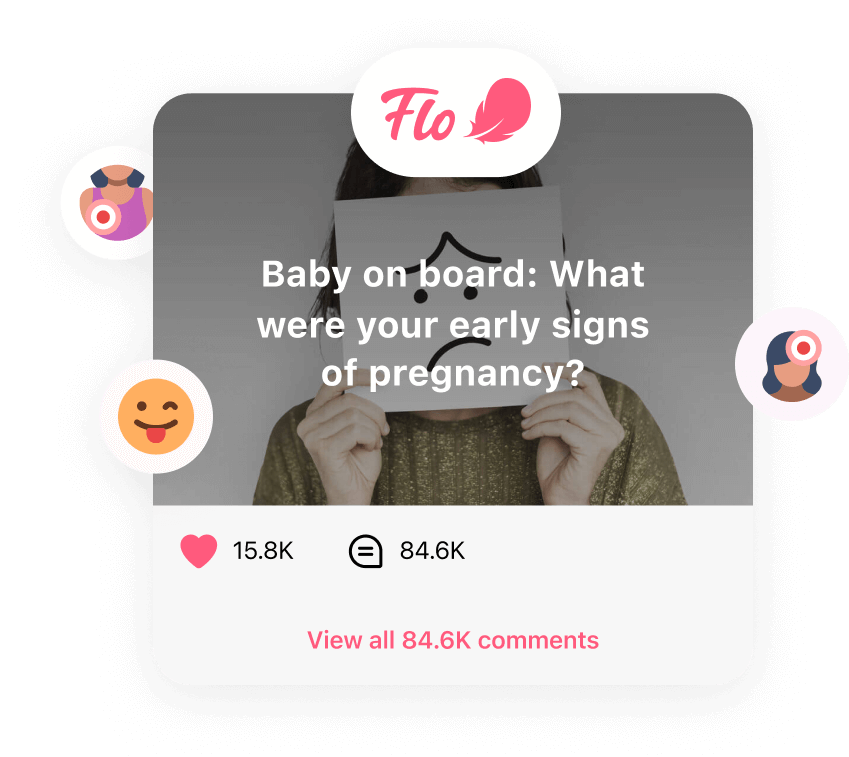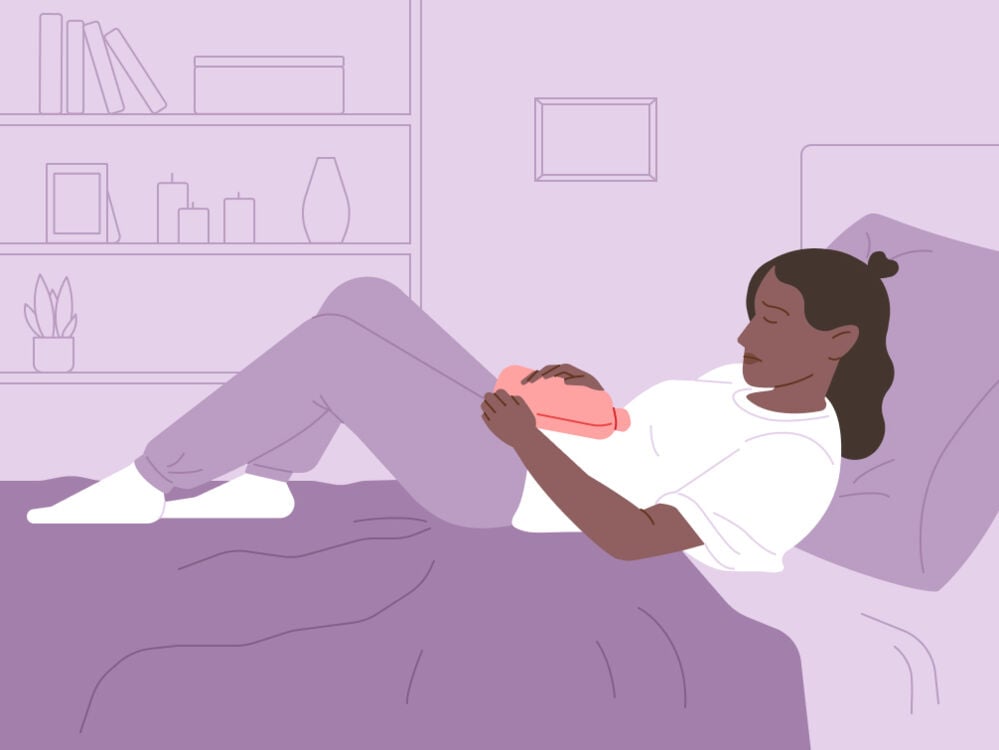You might most closely associate cramps with PMS, but did you know some people say they can feel when implantation happens? Here’s the lowdown on implantation cramps.
-
Tracking cycle
-
Getting pregnant
-
Pregnancy
-
Help Center
-
Flo for Partners
-
Anonymous Mode
-
Flo app reviews
-
Flo Premium New
-
Secret Chats New
-
Symptom Checker New
-
Your cycle
-
Health 360°
-
Getting pregnant
-
Pregnancy
-
Being a mom
-
LGBTQ+
-
Quizzes
-
Ovulation calculator
-
hCG calculator
-
Pregnancy test calculator
-
Menstrual cycle calculator
-
Period calculator
-
Implantation calculator
-
Pregnancy weeks to months calculator
-
Pregnancy due date calculator
-
IVF and FET due date calculator
-
Due date calculator by ultrasound
-
Medical Affairs
-
Science & Research
-
Pass It On Project New
-
Privacy Portal
-
Press Center
-
Flo Accuracy
-
Careers
-
Contact Us
Implantation cramps: What they feel like and when they happen


Every piece of content at Flo Health adheres to the highest editorial standards for language, style, and medical accuracy. To learn what we do to deliver the best health and lifestyle insights to you, check out our content review principles.
There are some symptoms that you probably associate with the early stages of pregnancy, like nausea or a dip in energy — but cramps? They’re more likely to indicate that your period is on its way, right? Not always.
Some people say that they can feel when their fertilized egg embeds into the lining of their uterus. Doctors call this process implantation — and it marks the moment you are officially pregnant. But is implantation cramping a thing? And if so, is it one of the very earliest signs of pregnancy? Plus, what do these cramps feel like? Let’s find out.
Key takeaways
- Implantation is the term used to describe when your fertilized egg attaches to your uterine lining. This is the point in your conception journey when you’re officially classed as being pregnant, and it can happen around six to ten days after a sperm fertilizes your egg.
- You might most closely associate belly cramps with the week before your period is due or premenstrual syndrome (PMS). However, it can happen at the start of pregnancy, too.
- The thought of cramps in early pregnancy might be worrying, but they’re actually quite common. They can be caused by a number of things — from gas to fluctuations in your hormones.
- The cramps you feel in early pregnancy shouldn’t be long-lasting and should go away by themselves. If you’ve noticed more severe pain or you’re worried, speak to your health care provider right away.

 Over
7.8M
ratings averaging
4.8/5
*
Over
7.8M
ratings averaging
4.8/5
*
Understand your body’s signals with the Flo app
- Chat with others who are trying to get pregnant.
- Get trusted information on signs of pregnancy from 100+ medical experts.
- Log your symptoms and learn what they could be trying to tell you.
 Over
7.8M
ratings averaging
4.8/5
*
Over
7.8M
ratings averaging
4.8/5
*

Trying to conceive?
The Flo app can help you through the two-week wait.

 Over
7.8M
ratings averaging
4.8/5
*
Over
7.8M
ratings averaging
4.8/5
*
Understand your body’s signals with the Flo app
- Chat with others who are trying to get pregnant.
- Get trusted information on signs of pregnancy from 100+ medical experts.
- Log your symptoms and learn what they could be trying to tell you.
What are implantation cramps?
Before we dig into the ins and outs of implantation cramps, here’s a recap on what implantation actually is.
Every cycle, one of your ovaries releases an egg. This is known as ovulation. It happens at around day 14 if you have an average 28-day cycle. You can use a cycle tracker like Flo to better understand when this might happen for you. After you’ve released an egg, it lives up to 24 hours. If it is fertilized by a sperm during this time, then you conceive.
Once this has happened, the fertilized egg travels down one of your fallopian tubes. It attaches to the lining of your uterus, ready to grow and develop into an embryo. This process is known as implantation and can take around six to ten days.
Take a quiz
Find out what you can do with our Health Assistant
Your body does lots of things each cycle to get ready for implantation. This includes releasing the hormone progesterone to prepare your uterine lining, which is full of blood vessels. The idea is that when your uterine lining is thick your fertilized egg then has the best chance of attaching firmly. Clever, eh?
In around a quarter of pregnancies, the fertilized egg bursts some of these blood vessels as it embeds. This is what’s known as implantation bleeding.
Some people also report feeling implantation cramps at the same time. However, not everyone spots this since your body goes through some monumental changes in the earliest stages of pregnancy. So, is it linked to the bleeding?
“Mild cramping in early pregnancy is very common,” explains Dr. Jennifer Boyle, obstetrician and gynecologist at Massachusetts General Hospital, US. “We don’t know exactly what causes this sensation. The fertilized egg is very tiny when it implants — much smaller than 1 mm or 0.04 inches in diameter. Because it’s so tiny, it is unlikely to cause many symptoms from implanting. Cramping in early pregnancy is thought to be caused by hormonal changes and the uterus growing.”
Since implantation happens around six to ten days after you’ve ovulated, any bleeding or cramps you notice may coincide with when you’re expecting your period. Pretty confusing! It’s early to know if you’re pregnant, even if you’ve been trying to conceive. So, it’s totally understandable if you miss these signs, confuse them with an early period, or don’t experience them at all.
When do pregnancy cramps start?
So now that we know that cramps are quite common in early pregnancy — and that they can be caused by implantation or your uterus growing to house your baby — when do they start?
This question is more tricky to answer because no two pregnancies are the same. As a general rule, though, cramps caused by implantation can happen as early as ten days after ovulation. Alternatively, some people start to feel symptoms linked to early pregnancy in the first few weeks after conceiving.
“Cramping directly attributable to implantation would only last for about one to two days at the very most,” explains Dr. Boyle. “However, cramping in early pregnancy is common and can continue for the first eight to 12 weeks.”
When you’re trying to get pregnant, it can be difficult not to look at every new twinge or ache and wonder if you could be expecting. This is totally normal. However, try to remember that pregnancy symptoms can vary between different people and different pregnancies.
If you haven’t noticed any cramping, this doesn’t necessarily mean implantation hasn’t happened. The only way to know for sure if you’re pregnant is to wait until you’ve missed a period and take a test.
What does implantation cramping feel like?
Since implantation generally happens around the time that you might expect your next period, it can be pretty easy to confuse implantation cramps and bleeding with an early period. However, Dr. Boyle explains that there are some telltale signs you can look out for that may separate PMS cramps from implantation pains.
She says that implantation cramping is usually much milder than period cramps. “It’s usually felt just above the pubic bone, in the middle,” she says. If you’re not sure exactly where this is on your body, you may be able to feel it if you press on the very lower part of your belly toward your genital area.
How long do implantation cramps last?
Again, it’s hard to pin down how long implantation cramps last with so little scientific evidence. But, as Dr. Flanagan explains: “Typically, they are very mild, and the person may experience them for a day or two.
“However, some people experience cramping in early pregnancy for many days, and again, this is likely related to fluctuating hormones and not the actual implantation of the pregnancy.”
If you notice unusual pain or cramping, it’s worth noting what you’re feeling and when (you can use an app like Flo for this). This might be useful to look back and help you determine whether the cramping could be specifically due to implantation or whether it’s more likely thanks to another cause.
“They’re typically different from menstrual cramps in that menstrual cramps tend to get stronger and stronger and then go away completely,” says Dr. Boyle. “Normal early pregnancy cramping tends to come and go but never be very intense.”
When you’re not sure if the cramps you’re feeling are linked to your cycle, pregnancy, or something else, it can be frustrating at best. If you’ve got questions about the way you feel, then you can always reach out to your doctor. If your cramps are linked to implantation, it may be too early to tell if you’re pregnant, but they will be able to talk you through any other symptoms you have and figure out the best next step.
Other early pregnancy signs
Implantation cramps aren’t actually classed as a common sign of early pregnancy since so much of what we know about them is anecdotal. However, if you suspect you might be pregnant, there are other signs and symptoms you can watch for, including:
- A missed period
- Nausea and vomiting
- Tiredness
- Sore boobs
- Peeing more
- Strange smells, tastes, and cravings
- Mood changes
- Bloating
- Light spotting (implantation bleeding)
- Constipation
- Headaches
This list might look pretty daunting. It’s long, after all — and not all of the signs on it are pleasant. However, if you start to notice a few of them, it may be a good idea to take a pregnancy test. You can also track your symptoms using an app like Flo to help you explain to your doctor how you’re feeling and when you first noticed changes.
What else could be causing cramping?
Your body goes through some monumental changes during pregnancy. As your hormone levels fluctuate to support you and your growing baby, you will likely spot a number of weird and wonderful symptoms that can impact the way you feel emotionally and physically.
While some people feel cramping during implantation, this isn’t the only time that you might feel aches or discomfort. As you move through the first few weeks of pregnancy, you may feel your uterus stretching in preparation for your growing baby. Gas and constipation can be common during early pregnancy. Similarly, bloating can leave you feeling pretty uncomfortable, and nausea may make your tummy feel sensitive.
Generally speaking, cramping during pregnancy should go away by itself and shouldn’t be severe. If you’re worried about any discomfort you’re feeling — or notice that it keeps returning with little explanation as to why — then the best thing to do is speak to your doctor.
Tips for relieving cramps at home
While cramps can be a normal part of early pregnancy, you don’t need to just put up with them. Finding out you’re having a baby can be a time of massive physical and emotional changes — and you deserve to be as comfortable as you can be every step of the way. Dr. Boyle says if your cramps don’t go away by themselves, you can try:
- Drinking lots of water: It’s recommended that you have around eight to 12 glasses of water a day, which might feel like a lot. However, if your cramps are caused by bloating or constipation, it will help to keep your bowels moving.
- Eating lots of fruit and vegetables: Fruit and vegetables are a great source of fiber and may help to combat trapped gas and constipation. Raspberries, green peas, and whole-wheat spaghetti are all great examples of foods that are high in fiber.

- Reaching for heat: A hot compress may ease your cramps.
- Doing light exercise if you can: Gentle yoga or walking may help.
- Taking over-the-counter medication: Pain relief that you can access over the counter may ease some of your cramps. It’s always good to speak to your doctor before taking any new medication to understand which one is right for you.
When to take a pregnancy test
Are you trying to get pregnant, and you felt some cramping? It’s totally normal to want to know if you’ve conceived.
Frustratingly, it’s still best to wait until the first day of your missed period before you take a pregnancy test. While this might feel so much easier said than done, there is a reason for it.
After implantation has happened, your body starts to release a hormone called human chorionic gonadotropin (hCG). This is what pregnancy tests look for in your pee. Your hCG levels start very low in the first few days of pregnancy and rise dramatically in your 1st trimester. This means that if you take a pregnancy test too early in your pregnancy, you risk getting an inaccurate result. By the first day of your missed period, your hCG levels should be high enough to be picked up by the test.
More FAQs about implantation cramps
Are implantation cramps on one side or both?
“Early implantation cramping or early pregnancy cramping should be felt right in the middle of the lower abdomen or pelvis and just above the pubic bone,” Dr. Boyle says. Remember, though, that no two people have exactly the same implantation cramps, so it’s normal if yours feel slightly different.
How many days after implantation are you pregnant?
Implantation marks the moment that you’re officially classed as being pregnant. It’s very early in the development, so your pregnancy may not be picked up by an at-home urine test. These tests look for the pregnancy hormone hCG in your pee. Your hCG levels are low at the start of pregnancy and then rise throughout your 1st trimester. That’s why it’s best to wait until the first day of a missed period to take a pregnancy test. By then, your hCG levels should be high enough to be picked up by the test.
Are quick, sharp pains normal in early pregnancy?
“Quick, sharp pains are normal in pregnancy,” Dr. Boyle explains. “The ligaments (or tissue bands) that connect the uterus to the sides of the body become really stretched in early pregnancy as the uterus quickly grows. Sudden movements or things like coughing can cause these ligaments to be pulled and a person might feel quick, sharp pains.” That said, you should always get pain in pregnancy checked out by a doctor.


Hey, I'm Anique
I started using Flo app to track my period and ovulation because we wanted to have a baby.


The Flo app helped me learn about my body and spot ovulation signs during our conception journey.


I vividly
remember the day
that we switched
Flo into
Pregnancy Mode — it was
such a special
moment.
Real stories, real results
Learn how the Flo app became an amazing cheerleader for us on our conception journey.
References
“Am I Pregnant?” Cleveland Clinic, my.clevelandclinic.org/health/articles/9709-pregnancy-am-i-pregnant. Accessed 11 Sep. 2024.
“Chart of High-Fiber Foods.” Mayo Clinic, 23 Nov. 2023, www.mayoclinic.org/healthy-lifestyle/nutrition-and-healthy-eating/in-depth/high-fiber-foods/art-20050948.
“How Much Water Should I Drink during Pregnancy?” The American College of Obstetricians and Gynecologists, Oct. 2020, www.acog.org/womens-health/experts-and-stories/ask-acog/how-much-water-should-i-drink-during-pregnancy.
“Human Chorionic Gonadotropin.” Cleveland Clinic, my.clevelandclinic.org/health/articles/22489-human-chorionic-gonadotropin. Accessed 11 Sep. 2024.
“Ice Packs vs. Warm Compresses for Pain.” Johns Hopkins Medicine, www.hopkinsmedicine.org/health/treatment-tests-and-therapies/ice-packs-vs-warm-compresses-for-pain. Accessed 11 Sep. 2024.
“Implantation Bleeding.” Cleveland Clinic, my.clevelandclinic.org/health/symptoms/24536-implantation-bleeding. Accessed 11 Sep. 2024.
“Ovulation.” Cleveland Clinic, my.clevelandclinic.org/health/articles/23439-ovulation. Accessed 11 Sep. 2024.
“Pregnancy: Identifying Fertile Days.” MedlinePlus, medlineplus.gov/ency/article/007015.htm. Accessed 11 Sep. 2024.
“Pregnancy Constipation.” Cleveland Clinic, my.clevelandclinic.org/health/diseases/21895-pregnancy-constipation. Accessed 11 Sep. 2024.
“Pregnancy Exercises.” Mayo Clinic, 15 Aug. 2023, www.mayoclinic.org/healthy-lifestyle/pregnancy-week-by-week/in-depth/pregnancy-exercises/art-20546799.
“Pregnancy Discomforts.” Cleveland Clinic, my.clevelandclinic.org/health/articles/pregnancy-pains. Accessed 11 Sep. 2024.
“Pregnancy Tests.” Cleveland Clinic, my.clevelandclinic.org/health/diagnostics/9703-pregnancy-tests. Accessed 11 Sep. 2024.
“Pubic Symphysis.” Cleveland Clinic, my.clevelandclinic.org/health/body/23025-pubic-symphysis. Accessed 11 Sep. 2024.
“Round Ligament Pain.” Cleveland Clinic, my.clevelandclinic.org/health/symptoms/21642-round-ligament-pain. Accessed 11 Sep. 2024.
Su, Ren-Wei, and Asgerally T. Fazleabas. “Implantation and Establishment of Pregnancy in Human and Nonhuman Primates.” Advances in Anatomy, Embryology, and Cell Biology, vol. 216, 2015, pp. 189–213, doi:10.1007/978-3-319-15856-3_10.
“Symptoms of Pregnancy: What Happens First.” Mayo Clinic, 13 Mar. 2024, www.mayoclinic.org/healthy-lifestyle/getting-pregnant/in-depth/symptoms-of-pregnancy/art-20043853.
“Stomach (Abdominal) Pain or Cramps in Pregnancy.” Tommy’s, www.tommys.org/pregnancy-information/pregnancy-symptom-checker/stomach-abdominal-pain-or-cramps-pregnancy. Accessed 11 Sep. 2024.
“Week 8.” NHS, www.nhs.uk/start-for-life/pregnancy/week-by-week-guide-to-pregnancy/1st-trimester/week-8/. Accessed 11 Sep. 2024.
History of updates
Current version (09 October 2024)
Published (23 December 2019)
In this article

Get your personal guide to fertility
-
Learn how to read your body's ovulation signals
-
Find daily conception tips from our experts
-
Chat with others who are trying to get pregnant




